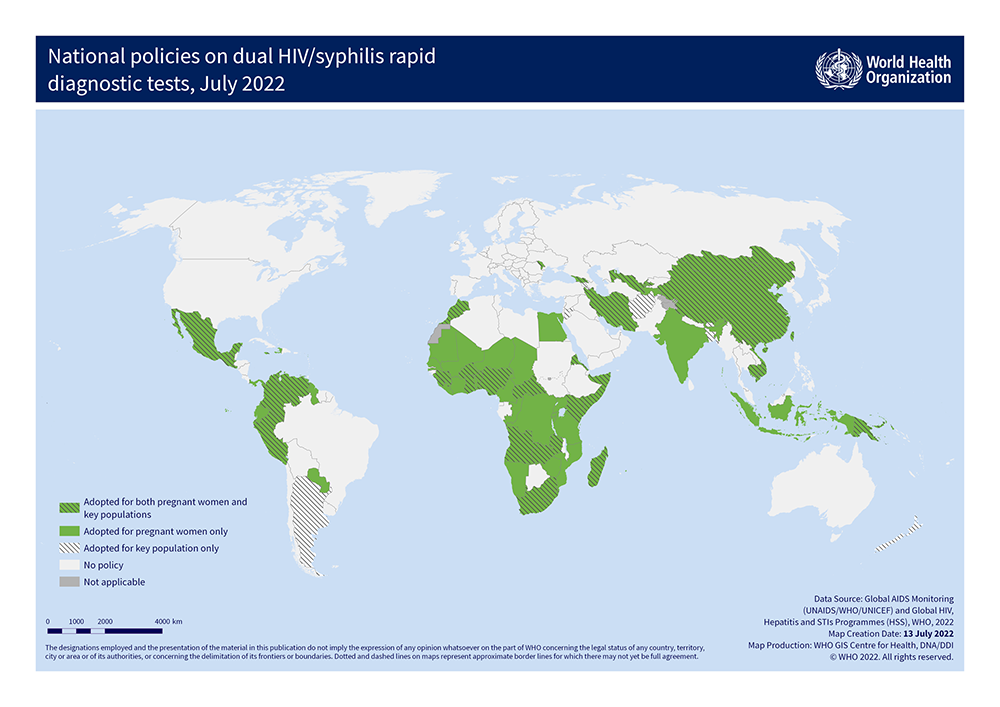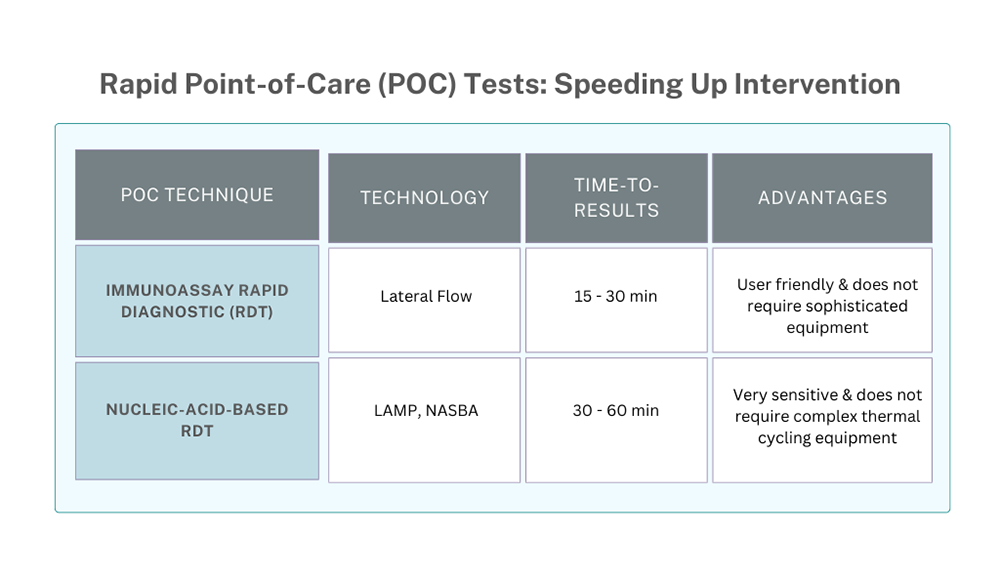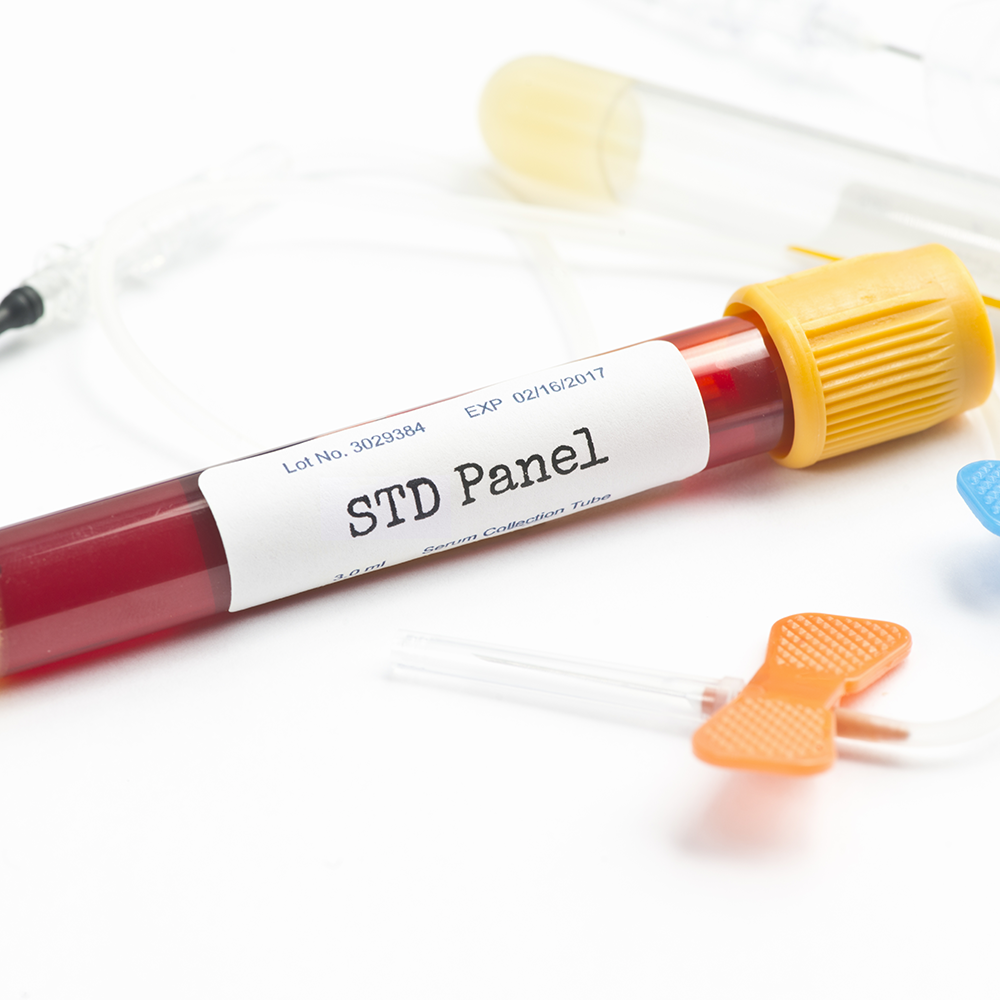More than one million sexually transmitted diseases (STDs) are acquired every day worldwide and eight pathogens are responsible for most of them: human immunodeficiency virus (HIV), hepatitis B (HBV), herpes simplex virus (HSV), human papillomavirus (HPV), syphilis, gonorrhea, chlamydia and trichomoniasis. Early detection plays a pivotal role in reducing STD transmission – and an effective STD diagnostic assay ideally meets several important criteria such as accuracy, reliability, accessibility, user-friendliness, privacy considerations, and adaptability to the dynamic nature of STDs.
In recent years there have been several advancements in STD diagnostic testing and in this blog, we will delve into a comprehensive review of the main technologies for point-of-care (POC) and high-throughput laboratory assays, and highlight the promising future that molecular and immunoassay techniques hold for STD diagnostics.
Current Molecular and Immunoassay Tests
Rapid Point-of-Care (POC) Tests: Speeding Up Intervention
Rapid tests utilizing molecular and immunoassay techniques have gained popularity for their speed in delivering quick results and are actively used for HIV, syphilis, and hepatitis diagnosis. In resource-limited settings, the World Health Organization (WHO) recommends RDTs (rapid diagnostic tests) for HIV, syphilis, and hepatitis B for all pregnant women at least once and as early as possible in certain high-prevalence regions (Figure 1). Dual HIV/syphilis RDTs, in particular, are recommended as a cost-saving alternative to standard testing and several dual HIV/syphilis RDTs have received WHO prequalification.1

However, RDT sensitivity can be low, especially in acute infections where the antibodies to the disease are still developing. New, emerging point-of-care nucleic acid tests (POC NATs) are positioned to improve the accuracy of current testing strategies when implemented in combination with RDTs.2

High-Throughput Laboratory-based Tests: Precision in Bulk
In addition to POC tests, high-throughput tests play an important role, especially when large-scale testing is required, such as population screening or during a public health crisis. Often POC tests are used for rapid initial screening, and laboratory tests are used to confirm a diagnosis. Laboratory tests also often provide quantitative measurements, allowing healthcare professionals to assess the severity of a condition, monitor changes over time, and tailor treatment plans accordingly. POC tests, on the other hand, typically provide qualitative (yes or no) results.
Some laboratory tests such as western blots and culture are still used but are not suitable for large-scale screening due to various factors such as time, labor, and technical complexity. The most common types of high-throughput laboratory-based assays are:
Enzyme-Linked Immunosorbent Assay (ELISA): ELISA is a type of laboratory-based test that uses blood or saliva specimens to detect antibodies or antigens to a variety of diseases. It can process large volumes of samples quickly, making it an ideal and cost-effective approach for large-scale screening programs. It is widely used in blood banks to screen donors for HIV, syphilis, and hepatitis B and C.3
PCR-based Nucleic Acid Amplification Tests: PCR-based molecular detection of an organisms’s nucleic acids (DNA or RNA) in clinical samples represents the gold standard for the diagnosis of many STDs. PCR has several advantages such as high detection sensitivity, can be easily automated, and can detect organisms that cannot be grown in culture or are non-viable, allowing the utilization of more diverse and less invasive biological samples (such as urine or vaginal swabs).4 Their unparalleled sensitivity enables the detection of low pathogen concentrations which is critical for early diagnosis and detecting extragenital infections, such as rectal or pharyngeal gonorrhea in men.5
Future Advancements in STD Testing
The future of STD testing will involve multiple advancements aimed at improving accessibility, accuracy, and efficiency. Current trends and developments in the future of STD testing include home testing, telemedicine and digital health platforms, technology innovations and multiplexing.
In order to circumvent the stigma associated with STD testing, point-of-care and home testing, along with telemedicine and digital health platforms are expanding, offering greater convenience and privacy. In addition, alternative sample types such as swabs, urine, and saliva are gaining popularity as they allow individuals to collect samples at home and send them to a laboratory for analysis.6
 The increasing prevalence of STDs and the need for efficient, accurate, and comprehensive diagnostic methods have driven the adoption of multiplex detection. Given several STDs are closely connected, co-infection with more than one STD is not uncommon. Multiplex detection, where multiple pathogens are tested simultaneously within a single assay, enables healthcare professionals more comprehensive and efficient screening, also saving time and resources.7
The increasing prevalence of STDs and the need for efficient, accurate, and comprehensive diagnostic methods have driven the adoption of multiplex detection. Given several STDs are closely connected, co-infection with more than one STD is not uncommon. Multiplex detection, where multiple pathogens are tested simultaneously within a single assay, enables healthcare professionals more comprehensive and efficient screening, also saving time and resources.7
In addition, technology innovations and integrations of advanced techniques such as molecular diagnostics and biosensors, lab-on-a-chip, and next-generation sequencing (NGS) will contribute to improved accuracy, accessibility, and efficiency of STD.
Next-Generation Sequencing (NGS): Unleashing Genetic Insight
Through the use of next-generation sequencing (NGS), the emerging field of clinical metagenomics could potentially revolutionize STD testing. NGS allows for rapid and comprehensive diagnosis by providing useful medical information in a single test. This includes universal pathogen detection, species determination, and identification of antimicrobial resistance. NGS, although more expensive than traditional culture or NAATs, could revolutionize our understanding of the genetic diversity of STD-causing agents and be more cost-effective in many situations by reducing the number of tests required.8
CRISPR-Based Diagnostics: Precision Redefined
Emerging as cutting-edge technology, CRISPR-based diagnostics offer highly specific and sensitive detection of nucleic acids. Molecular methods for detecting nucleic acids based on CRISPR-Cas systems appear to be highly sensitive, specific, and capable of one-step detection of both RNA and DNA. These tests have the potential to enhance the accuracy of STD diagnostics, becoming valuable tools for point-of-care testing.9
Microfluidic and Lab-on-a-Chip Technologies: Portability Redefined
Miniaturized technologies such microfluidic devices and lab-on-a-chip platforms hold promise for developing highly portable and efficient diagnostic tools. These technologies could bring sophisticated testing capabilities to even the most remote locations. Their miniaturized and integrated nature contributes to increased efficiency and reduced sample and volumes, when incorporated into microarrays, can be applied to high-throughput analysis of biomolecules, such as DNA, RNA, proteins, or cells.3
Conclusion
Molecular and immunoassay tests have revolutionized STD diagnostics, offering accuracy, efficiency, and accessibility. The current state of these tests forms a robust foundation for the future, where innovations such as NGS, CRISPR-based diagnostics, multiplex immunoassays, and microfluidic technologies are poised to elevate the precision and convenience of STD testing. As these advancements continue to unfold, the outlook for early detection, treatment, and prevention of STDs becomes increasingly optimistic.
Meridian’s Molecular & Immunoassay STD Diagnostic Solutions
As a leader in infectious diseases, Meridian Bioscience has supported assay developers for over 45 years with innovative reagent solutions for STD diagnostic assays. With over 200 antigens and antibodies for STD immunoassay testing, and a large range of master mixes and enzymes for qPCR and isothermal amplification applications, Meridian is ready to provide solutions, big and small to support STD diagnostics.
To learn more, visit Meridian’s complete STD solutions webpage: https://info.meridianbioscience.com/meridian-reagent-solutions-for-std-diagnostics
References:
- Centers for Disease Control and Prevention. Impact of COVID-19 on STDs. https://www.cdc.gov/std/statistics/2021/impact.htm. Accessed Nov 15, 2023.
- World Health Organization. Global Sexually Transmitted Infections Programme: Dual HIV/syphilis rapid diagnostic tests. Available at: https://www.who.int/teams/global-hiv-hepatitis-and-stis-programmes/stis/testing-diagnostics/dual-hiv-syphilis-rapid-diagnostic-tests. Accessed 28 November 2023.
- World Health Organization. WHO encourages countries to adapt HIV testing strategies in response to changing epidemic. 2019. Available at: https://www.who.int/publications-detail/who-encourages-countries-to-adapt-hiv-strategies. Accessed 28 November 2023.
- American Red Cross. Infectious Disease, HLA and ABO Donor Qualification Testing. Available at: https://www.redcrossblood.org/biomedical-services/blood-diagnostic-testing/blood-testing.html. Accessed 28 November 2023.
- Caruso, G., Giammanco, A., Virruso, R., Fasciana, T. (2021) Current and Future Trends in the Laboratory Diagnosis of Sexually Transmitted Infections. Int J Environ Res Public Health.18(3):1038. doi: 10.3390/ijerph18031038.
- Cornelisse, V.J., et al. (2017) Increased Detection of Pharyngeal and Rectal Gonorrhea in Men Who Have Sex With Men After Transition From Culture To Nucleic Acid Amplification Testing. Sex. Transm. Dis.;44:114–117. doi: 10.1097/OLQ.0000000000000553
- Arnold, C. (2022) Home testing for syphilis gains support in wake of COVID. Nature. 605, 598-599. doi: https://doi.org/10.1038/d41586-022-01363-1
- Naeem, F., Karellis, A., Nair, S., Routy, J.P., Yansouni, C.P., Kim, J., Pai, N. (2021) Multiplexed technologies for sexually transmitted infections: global evidence on patient-centered and clinical health outcomes. BMJ Glob Health. 6(7):e005670. doi: 10.1136/bmjgh-2021-005670.
- Moretti, M. (2022) Latest Technological Advancements for STI Detection. Today’s Clinical Lab Trends. March 214, 2022. Available at: https://www.clinicallab.com/trends/molecular-diagnostics/latest-technological-advancements-for-sti-detection-26293
- Kostyusheva, A., Brezgin, S., Babin, Y., Vasilyeva, I., Glebe, D., Kostyushev, D., Chulanov, V. (2022) CRISPR-Cas systems for diagnosing infectious diseases. Methods. 203:431-446. doi: 10.1016/j.ymeth.2021.04.007.